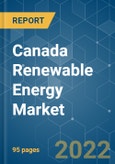The Canadian renewable energy market is expected to register a CAGR of around 9% during the forecast period. The COVID-19 pandemic did not significantly impact the Canadian renewable energy market as the under-construction renewable projects continued. For example, the solar PV installed capacity in 2020 was around 3,342 MW, which was higher than in 2019. The country’s renewable energy market is likely to grow in the future due to technological developments in the field, particularly the grid-integration technology development and the diversification of clean energy generating sources. However, the highly centralized and regulated electricity sector hampers the market's growth.
The Canadian renewable energy market is fragmented. Some of the key players include Canadian Solar Inc., Electricite de France SA (EDF Renewables), Engie SA, Siemens Gamesa Renewable Energy SA, and Vestas Wind Systems AS.
This product will be delivered within 2 business days.
Key Highlights
- The wind energy segment is expected to witness significant growth during the forecast period due to the several upcoming wind power projects in the country.
- The Canadian government pledged to phase out coal in the coming years, creating ample opportunities for deeper penetration of renewables in the energy sector. In 2021, the Ministry of Environment and Climate Change implemented a plan to phase out coal-fired electricity by 2030 and achieve carbon neutrality by 2050.
- The tremendously high government support for renewables-based power generation is expected to bolster the market's growth in the future.
Key Market Trends
Wind Energy Expected to Witness Significant Growth
- Canada has been markedly developing the renewable energy sector for decades. It expanded its renewable electricity fleet substantially due to the milestones achieved in research and innovation, which led to better commercialization of renewable technologies. Hydropower dominates the country’s renewable power domain, whereas it has unprecedently witnessed huge growth in the wind energy sector in recent years.
- Wind technology held a share of 13% in the renewable electricity mix and 3% in the overall electricity generation mix as of 2020, owing to the falling costs and technological development. In 2021, it witnessed an increment in the installed capacity of about 677 MW with new utility-scale projects that came online in the said year. The most highlighted provinces in the progress of wind energy are Ontario, Quebec, and Alberta. However, these provinces still have a long way to achieve the carbon-neutrality target by 2050.
- The country planned around 31 more wind projects recently. For instance, in December 2021, a consortium of renewable industry players planned a wind power project, Sharp Hills Wind Project, in Alberta. The 298-MW project will be developed in multiple phases by Alberta Wind Energy, EDP Renewables Canada, and Eolectric. It is likely to be in service in 2023.
- The country anticipates one more large-scale wind power project, Yarmouth offshore wind project. This project is a 1-GW offshore wind farm, 20 km off the coast of Yarmouth, Nova Scotia, with a depth range of 44-60 m and 10 m/s wind speed. The project's commercial operation is expected in 2025, after the completed construction by Beothuk Energy.
- Such developments may have an overwhelming effect on wind technology development in the country.
Government Support Expected to Drive the Market
- Canada has made incredible achievements in renewable energy development, made possible with government support. The Canadian energy department offered great financial support to the projects to accelerate the clean energy transition. It also offered incentives for the use of renewable sources of power generation for commercial users and homeowners.
- Renewable energy sources accounted for around 71% of the power generation mix as of 2020. The country witnessed a high-paced growth in wind and solar energy penetration, with new capacities installed across the country in the last five years. According to the Canada Renewable Energy Association (CANREA), in 2021, around 1 GW of solar and wind capacity was installed, with the major share held by the Alberta region. However, the target of net-zero emissions by 2050 requires more effort from the government to reach the goal. Thus, the Canadian government has initiated many new programs to financially support renewable projects.
- In October 2021, the Canadian government announced plans to contribute CAD 44.8 million to 60 new electric buses originating from Halifax Regional Municipality. The funding will also be utilized to expand the project to Ragged Lake Transit Centre. The facility will be installed with solar panels to achieve a net-zero standard. The construction will start in 2022 and be completed in 2023.
- The government also contributed to the technical development of grid networks for better integration of renewable technologies. For instance, in 2021, it launched a USD 964-million program to support the upcoming smart renewable energy and grid-modernization projects. The funds will be allocated particularly for investments in clean energy technologies, like wind, solar, storage, hydro, geothermal, and tidal.
- Such initiatives by the Canadian authorities will significantly impact the growth of renewables in the country.
Competitive Landscape
The Canadian renewable energy market is fragmented. Some of the key players include Canadian Solar Inc., Electricite de France SA (EDF Renewables), Engie SA, Siemens Gamesa Renewable Energy SA, and Vestas Wind Systems AS.
Additional Benefits:
- The market estimate (ME) sheet in Excel format
- 3 months of analyst support
This product will be delivered within 2 business days.
Table of Contents
1 INTRODUCTION
4 MARKET OVERVIEW
5 MARKET SEGMENTATION
6 COMPETITIVE LANDSCAPE
Companies Mentioned (Partial List)
A selection of companies mentioned in this report includes, but is not limited to:
- Canadian Solar Inc.
- Electricite de France SA (EDF Renewables)
- Engie SA
- Siemens Gamesa Renewable Energy SA
- Vestas Wind Systems AS
- Acciona SA
- EDP Renovaveis SA
- Enel SpA
- IOGEN Corporation
- Bio-EnPower Inc.
Methodology

LOADING...








